A Novel Adaptive Two-Stage Information Filter Approach for Deep-Sea USBL/DVL Integrated Navigation
Abstract
1. Introduction
2. Integrated Navigation Model
2.1. System Model
2.2. Observation Model
2.3. Integrated Navigation Model
- The USBL observation contains obvious measurement noise, which is related to the distance and changes with space and time.
- The other systematic errors, such as calibration errors and constant deviations of depth gauges, can be corrected by augmenting parameters.
- There are time-varying and saltation ocean currents.
3. Adaptive Two-Stage Information Filter Design
3.1. The Two-Stage Information Filter
| Algorithm 1: Two-Stage Information Filter (TSIF). | |
| 1. Initialization: | |
| ,,,,.
2. Input: observation | (30) |
| 3. Recursive computation: For k = 1, 2, 3, … | |
| (1). Information filtering (IF): | |
| , | (31) |
| , | (32) |
| , | (33) |
| , | (34) |
| . | (35) |
| (2). Innovation and covariance: | |
| , | (36) |
| . | (37) |
| (3). Correction: | |
| , | (38) |
| , | (39) |
| , | (40) |
| , | (41) |
| , | (42) |
| , | (43) |
| . | (44) |
| (4). Modified state: | |
| . | (45) |
| 4. Output: and | |
3.2. The Adaptive Estimation of Unknown Current Velocity
3.2.1. Diagnosis of Unknown Ocean Currents and the Saltation Ocean Currents
3.2.2. Diagnosis of Abnormal USBL Data
3.2.3. Estimation of the Time-Varying Currents
| Algorithm 2: Adaptive Two-Stage Information Filter (TSIF). | |
| 1. Initialization: | |
| , , , , , . | (49) |
| 2. Input: observation | |
| 3. Recursive computation: For k = 1, 2, 3, … | |
| (1). Information filtering (IF): | |
| , | (50) |
| , | (51) |
| , | (52) |
| , | (53) |
| . | (54) |
| (2). Innovation and covariance: | |
| , | (55) |
| . | (56) |
| . | (57) |
| (3). Correction: | |
| , | (58) |
| , | (59) |
| , | (60) |
| , | (61) |
| , | (62) |
| , | (63) |
| . | (64) |
| (4). Modified state: | |
| . | (65) |
| 4. Output: and | |
3.3. The Adaptive Estimation of the Measurement Noise Covariance
4. Experiment Analysis
4.1. Simulation Results
4.2. Deep-Sea Towed Vehicle Experiment
5. Conclusions
6. Patents
Author Contributions
Funding
Acknowledgments
Conflicts of Interest
Nomenclature
| , , | the lever arms vectors of the USBL transponder, DVL and pressure gauge |
| the positions of AHRS in local navigation coordinate frame {n} | |
| , | the direction cosine matrix (DCM) from {b} to {m} and from {m} to {n} |
| the attitude angle of {b} relative to {m} and form {m} to {n} | |
| the distance between the transponder and the transducer | |
| the velocity of the AHRS relative to fluid and angular velocity in {m} | |
| the ocean currents velocity in {n} | |
| the position of the receiver in {n} | |
| the position of the pressure gauge in {n} | |
| the depth of the pressure gauge in {n} | |
| the state parameters | |
| the state parameters estimation |
Appendix A
Appendix B
References
- Yoerger, D.R.; Jakuba, M.; Bradley, A.M.; Bingham, B. Techniques for deep sea near bottom survey using an autonomous underwater vehicle. Int. J. Robot. Res. 2007, 26, 41–54. [Google Scholar] [CrossRef]
- McPhail, S.D.; Pebody, M. Range-only positioning of a deep-diving autonomous underwater vehicle from a surface ship. IEEE J. Ocean. Eng. 2009, 34, 669–677. [Google Scholar] [CrossRef]
- Paull, L.; Saeedi, S.; Seto, M.; Li, H. AUV navigation and localization: A review. IEEE J. Ocean. Eng. 2014, 39, 131–149. [Google Scholar] [CrossRef]
- Morgado, M.; Batista, P.; Oliveira, P.; Silvestre, C. Position USBL/DVL sensor-based navigation filter in the presence of unknown ocean currents. In Proceedings of the 49th IEEE Conference on Decision and Control (CDC), Atlanta, GA, USA, 15–17 December 2010; pp. 2192–2197. [Google Scholar]
- Daxiong, J.; Jian, L.; Rong, Z. Acoustic Theory Application in Ultra Short Baseline System for Tracking AUV. Mar. Geod. 2013, 36, 428–435. [Google Scholar] [CrossRef]
- Viegas, D.; Batista, P.; Oliveira, P.; Silvestre, C. Position and velocity filters for intervention AUVs based on single range and depth measurements. In Proceedings of the 2012 IEEE International Conference on Robotics and Automation, Saint Paul, MN, USA, 14–18 May 2012; pp. 4878–4883. [Google Scholar]
- Dukan, F.; Sørensen, A.J. Integration filter for USBL, DVL, IMU and pressure gauge for underwater vehicles. IFAC Proc. Vol. 2013, 46, 280–285. [Google Scholar] [CrossRef]
- Brokloff, N.A. Dead reckoning with an ADCP and current extrapolation. In Proceedings of the Oceans’ 97. MTS/IEEE Conference Proceedings, Halifax, NS, Canada, 6–9 October 1997; Volume 2, p. 1411. [Google Scholar]
- Lee, P.; Jeon, B.; Kim, S.; Choi, H.; Lee, C.; Aoki, T.; Hyakudome, T. An integrated navigation system for autonomous underwater vehicles with two range sonars, inertial sensors and Doppler velocity log. In Proceedings of the Oceans’ 04 MTS/IEEE Techno-Ocean’ 04 (IEEE Cat. No.04CH37600), Kobe, Japan, 9–12 November 2004; Volume 3, pp. 1586–1593. [Google Scholar]
- Rigby, P.; Pizarro, O.; Williams, S.B. Towards Geo-Referenced AUV Navigation Through Fusion of USBL and DVL Measurements. In Proceedings of the OCEANS 2006, Boston, MA, USA, 18–21 September 2006; pp. 1–6. [Google Scholar]
- Scherbatyuk, A.P.; Dubrovin, F.S. Some Algorithms of AUV Positioning Based on One Moving Beacon. IFAC Proc. Vol. 2012, 45, 1–6. [Google Scholar] [CrossRef]
- Refsnes, J.E.; Sorensen, A.J.; Pettersen, K.Y. Robust observer design for underwater vehicles. In Proceedings of the 2006 IEEE Conference on Computer Aided Control System Design, 2006 IEEE International Conference on Control Applications, 2006 IEEE International Symposium on Intelligent Control, Munich, Germany, 4–6 October 2006; pp. 313–319. [Google Scholar]
- Allotta, B.; Caiti, A.; Costanzi, R.; Fanelli, F.; Fenucci, D.; Meli, E.; Ridolfi, A. A new AUV navigation system exploiting unscented Kalman filter. Ocean Eng. 2016, 113, 121–132. [Google Scholar] [CrossRef]
- Friedland, B. Treatment of bias in recursive filtering. IEEE Trans. Autom. Control 1969, 14, 359–367. [Google Scholar] [CrossRef]
- Steven, G.; Bart, D.M. Unbiased minimum-variance input and state estimation for linear discrete-time systems. Automatica 2007, 43, 111–116. [Google Scholar]
- Kitanidis, P.K. Unbiased minimum-variance linear state estimation. Automatica 1987, 23, 775–778. [Google Scholar] [CrossRef]
- Cheng, Y.; Ye, H.; Wang, Y.; Zhou, D. Unbiased minimum-variance state estimation for linear systems with unknown input. Automatica 2009, 45, 485–491. [Google Scholar] [CrossRef]
- Míguez, J. Analysis of selection methods for cost-reference particle filtering with applications to maneuvering target tracking and dynamic optimization. Digit. Signal Process. 2007, 17, 787–807. [Google Scholar] [CrossRef]
- Martino, L.; Read, J.; Elvira, V.; Louzada, F. Cooperative Parallel Particle Filters for on-Line Model Selection and Applications to Urban Mobility. Digit. Signal Process. 2017, 60, 172–185. [Google Scholar] [CrossRef]
- Caron, F.; Davy, M.; Duflos, E.; Vanheeghe, P. Particle filtering for multisensor data fusion with switching observation models: Application to land vehicle positioning. IEEE Trans. Signal Process. 2007, 55, 2703–2719. [Google Scholar] [CrossRef]
- Lu, P.; Van Kampen, E.J.; De Visser, C.C.; Chu, Q. Framework for state and unknown input estimation of linear time-varying systems. Automatica 2016, 73, 145–154. [Google Scholar] [CrossRef]
- Pouria, T.S.; Stefan, W. Distributed Kalman Filtering in Presence of Unknown Outer Network Actuations. IEEE Control Syst. Lett. 2019, 1, 186–191. [Google Scholar]
- Ansari, A.; Bernstein, D.S. Deadbeat unknown-input state estimation and input reconstruction for linear discrete-time systems. Automatica 2019, 103, 11–19. [Google Scholar] [CrossRef]
- Sun, S.L.; Deng, Z.L. Multi-sensor optimal information fusion Kalman filter. Automatica 2004, 40, 1017–1023. [Google Scholar] [CrossRef]
- Bayat, M.; Crasta, N.; Aguiar, A.P.; Pascoal, A.M. Range-based underwater vehicle localization in the presence of unknown ocean currents: Theory and experiments. IEEE Trans. Control Syst. Technol. 2016, 24, 122–139. [Google Scholar] [CrossRef]
- Williams, D.P.; Baralli, F.; Micheli, M.; Vasoli, S. Adaptive underwater sonar surveys in the presence of strong currents. In Proceedings of the 2016 IEEE International Conference on Robotics and Automation (ICRA), Stockholm, Sweden, 16–21 May 2016; pp. 2604–2611. [Google Scholar]
- Peng, S.; Chen, B.; Sun, L.; Ser, W.; Lin, Z. Constrained maximum correntropy adaptive filtering. Signal Process. 2017, 140, 116–126. [Google Scholar] [CrossRef]
- Peng, S.; Ser, W.; Chen, B.; Sun, L.; Lin, Z. Robust constrained adaptive filtering under minimum error entropy criterion. IEEE Trans. Circuits Syst. Ii Express Briefs 2018, 65, 1119–1123. [Google Scholar] [CrossRef]
- Zhang, Q. Adaptive Kalman filter for actuator fault diagnosis. Automatica 2018, 93, 333–342. [Google Scholar] [CrossRef]
- Zheng, B.; Fu, P.; Li, B.; Yuan, X. A robust adaptive unscented Kalman filter for nonlinear estimation with uncertain noise covariance. Sensors 2018, 18, 808. [Google Scholar] [CrossRef] [PubMed]
- Yang, Y.; Xu, T. An adaptive Kalman filter based on Sage windowing weights and variance components. J. Navig. 2003, 56, 231–240. [Google Scholar] [CrossRef]
- Mohamed, A.H.; Schwarz, K.P. Adaptive Kalman filtering for INS/GPS. J. Geod. 1999, 73, 193–203. [Google Scholar] [CrossRef]
- Yang, Y.; Gao, W. An Optimal Adaptive Kalman Filter. J. Geod. 2006, 80, 177–183. [Google Scholar] [CrossRef]
- Kinsey, J.C.; Whitcomb, L.L. In situ alignment calibration of attitude and doppler sensors for precision underwater vehicle navigation: Theory and experiment. IEEE J. Ocean. Eng. 2007, 32, 286–299. [Google Scholar] [CrossRef]
- Peyronnet, J.P.; Person, R.; Rybicki, F. POSIDONIA 6000: A new long range highly accurate ultra-short base line positioning system. In Proceedings of the IEEE Oceanic Engineering Society. Oceans’ 98. Conference Proceedings (Cat. No.98CH36259), Nice, France, 28 September–1 October 1998; Volume 3, pp. 1721–1727. [Google Scholar]
- Batista, P.; Silvestre, C.; Oliveira, P. Optimal position and velocity navigation filters for autonomous vehicles. Automatica 2010, 46, 767–774. [Google Scholar] [CrossRef]
- Ridao, P.; Ribas, D.; Hernandez, E.; Rusu, A. USBL/DVL navigation through delayed position fixes. In Proceedings of the 2011 IEEE International Conference on Robotics and Automation, Shanghai, China, 9–13 May 2011; pp. 2344–2349. [Google Scholar]
- Dhanak, M.R.; Xiros, N.I. Springer Handbook of Ocean Engineering; Springer: Berlin/Heidelberg, Germany, 2016. [Google Scholar] [CrossRef]
- Lifen, S.; Yanyu, L.; Wei, W. Adaptive Sequential Adjustment and Its Application. Geomat. Inf. Sci. Wuhan Univ. 2007, 32, 51–54. [Google Scholar]
- Grewal, M.; Andrews, A. Kalman Filtering: Theory and Practice Using MATLAB; John Wiley & Sons: Manhattan, NY, USA, 2015; Volume 84, pp. 46–47. [Google Scholar]
- Zhang, Q. Adaptive observer for multiple-input-multiple-output (MIMO) linear time-varying systems. IEEE Trans. Autom. Control 2002, 47, 525–529. [Google Scholar] [CrossRef]
- Tsai, J.S.-H.; Lin, M.-H.; Zheng, C.-H.; Guo, S.-M.; Shieh, L.-S. Actuator fault detection and performance recovery with Kalman filter-based adaptive observer. Int. J. Gen. Syst. 2007, 36, 375–398. [Google Scholar] [CrossRef]
- Jiang, L.; Zhang, H. Redundant measurement-based second order mutual difference adaptive Kalman filter. Automatica 2019, 100, 396–402. [Google Scholar] [CrossRef]
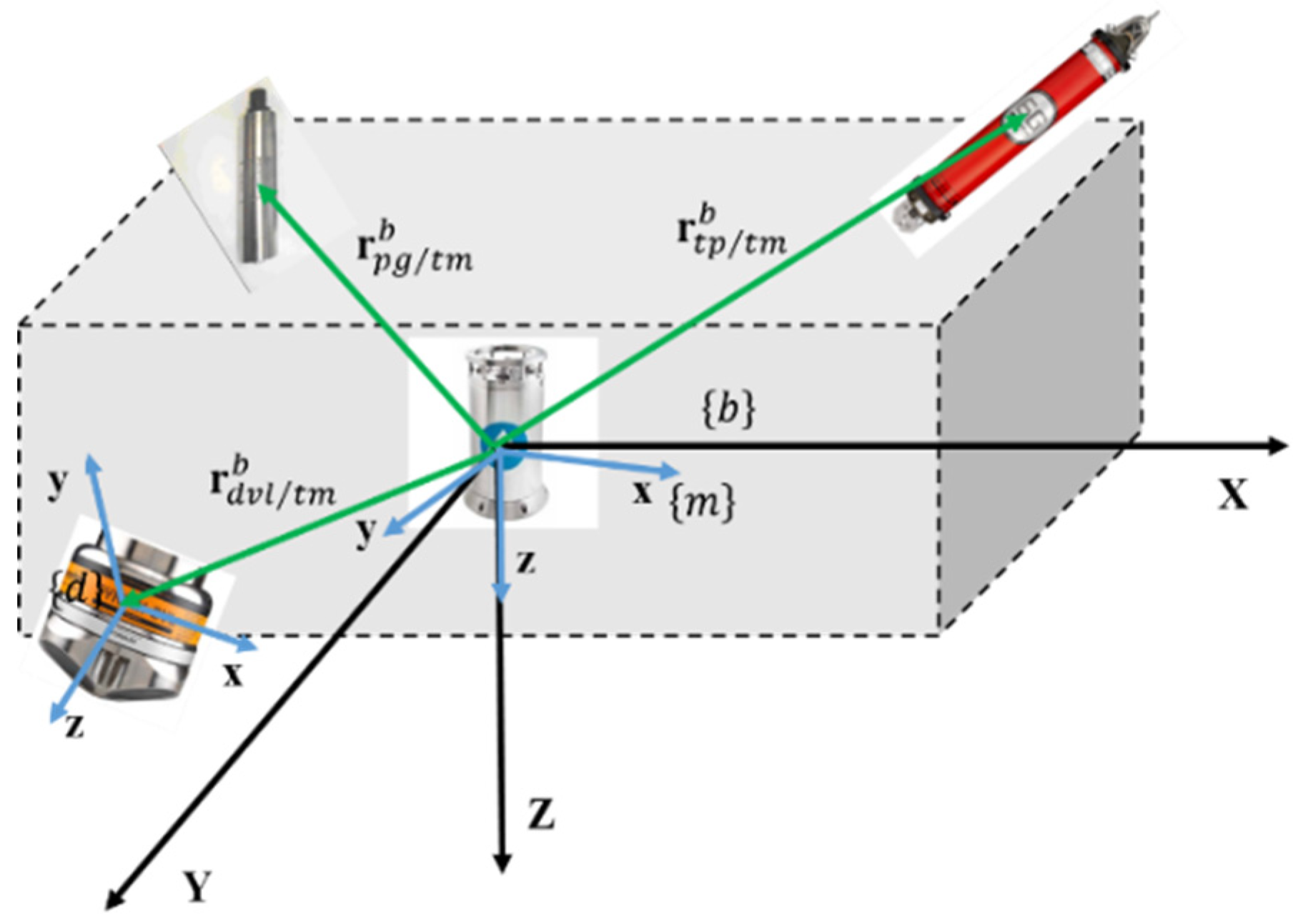
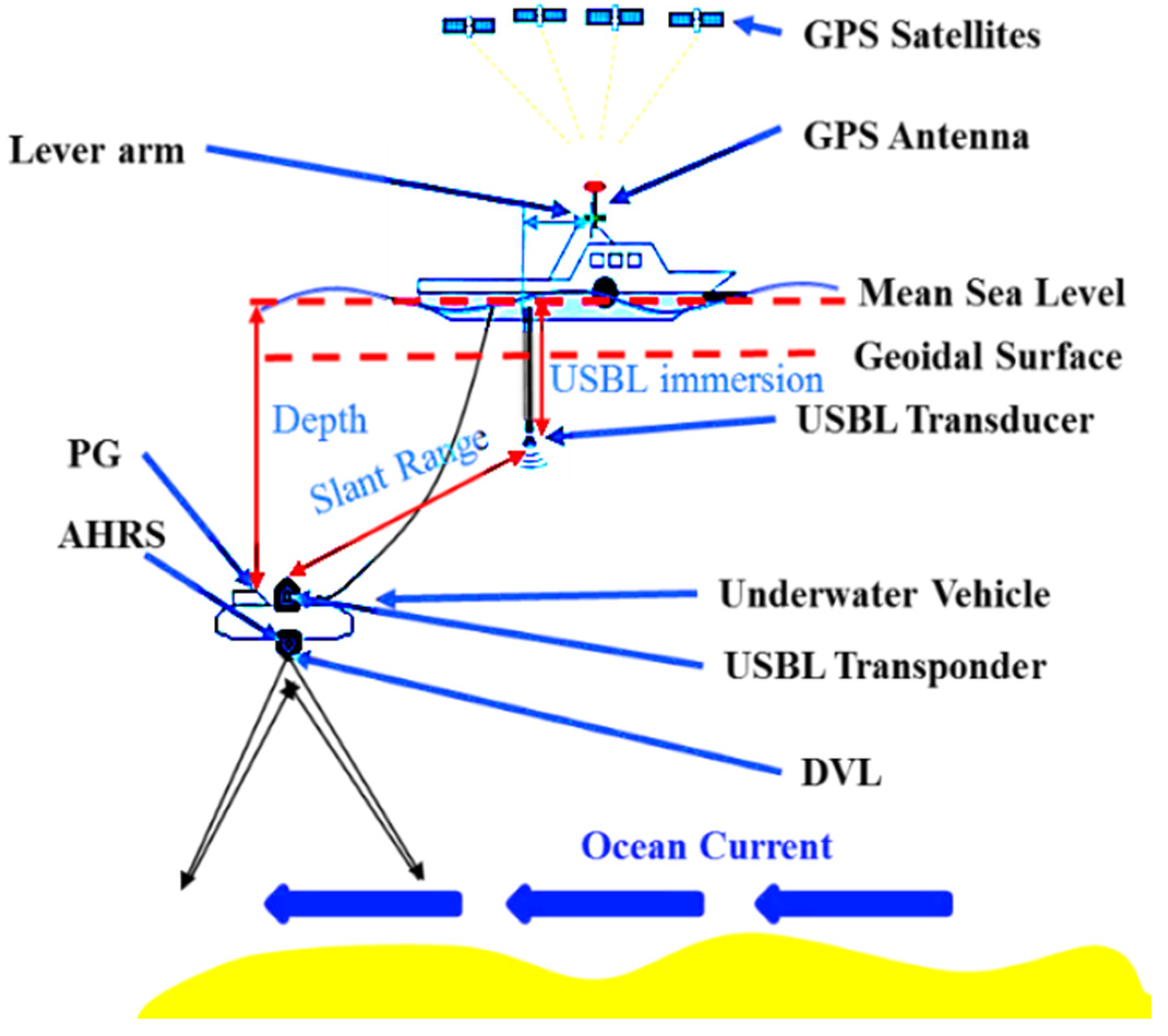

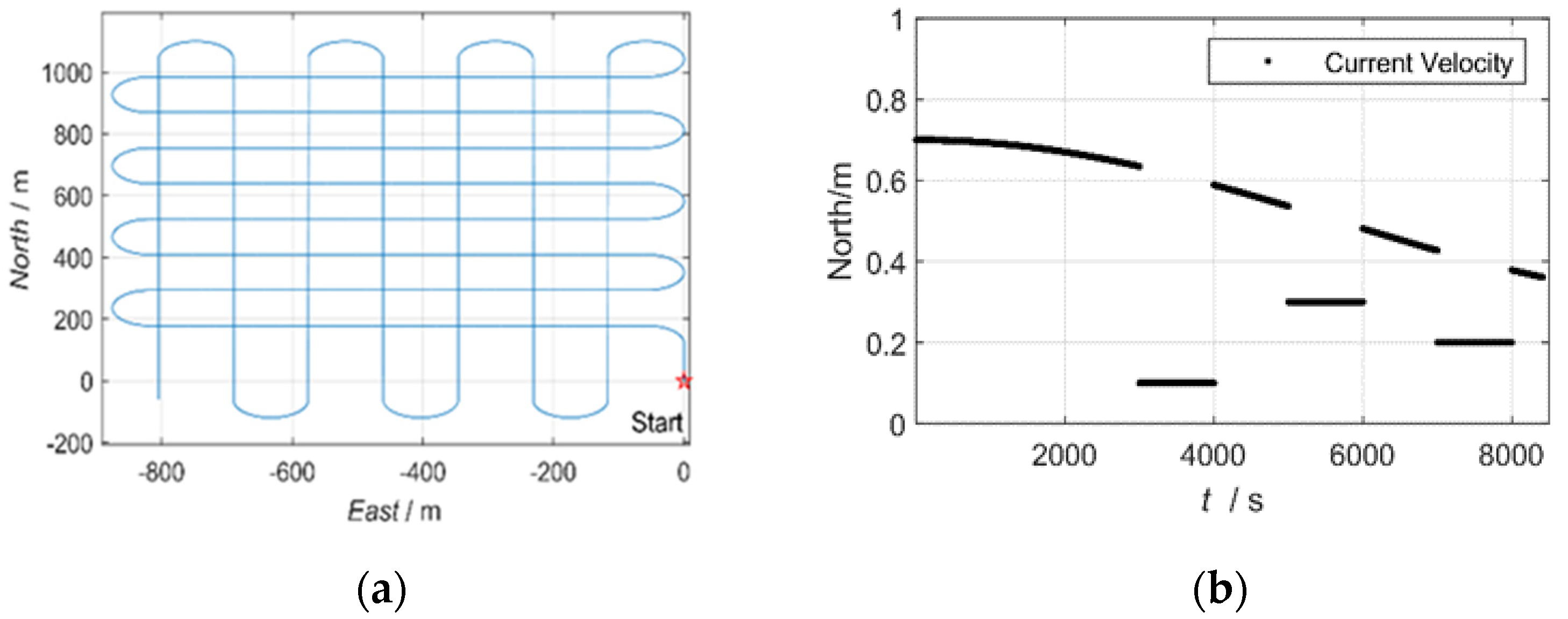
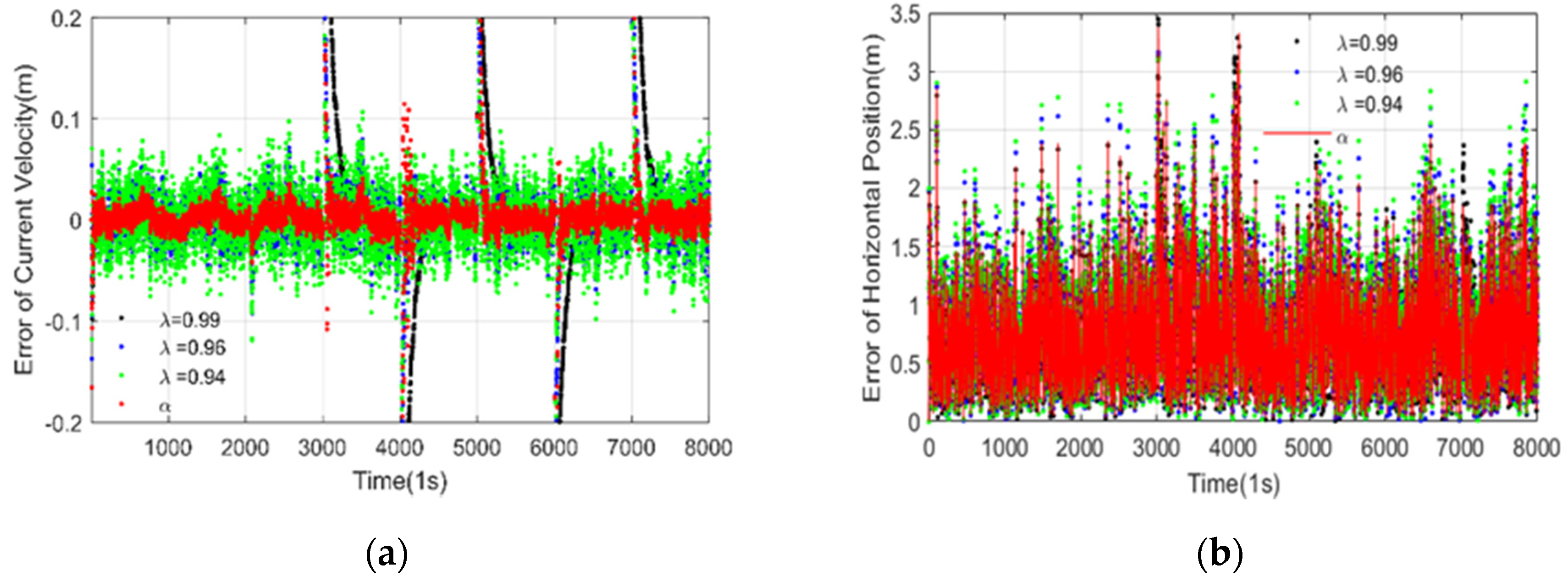
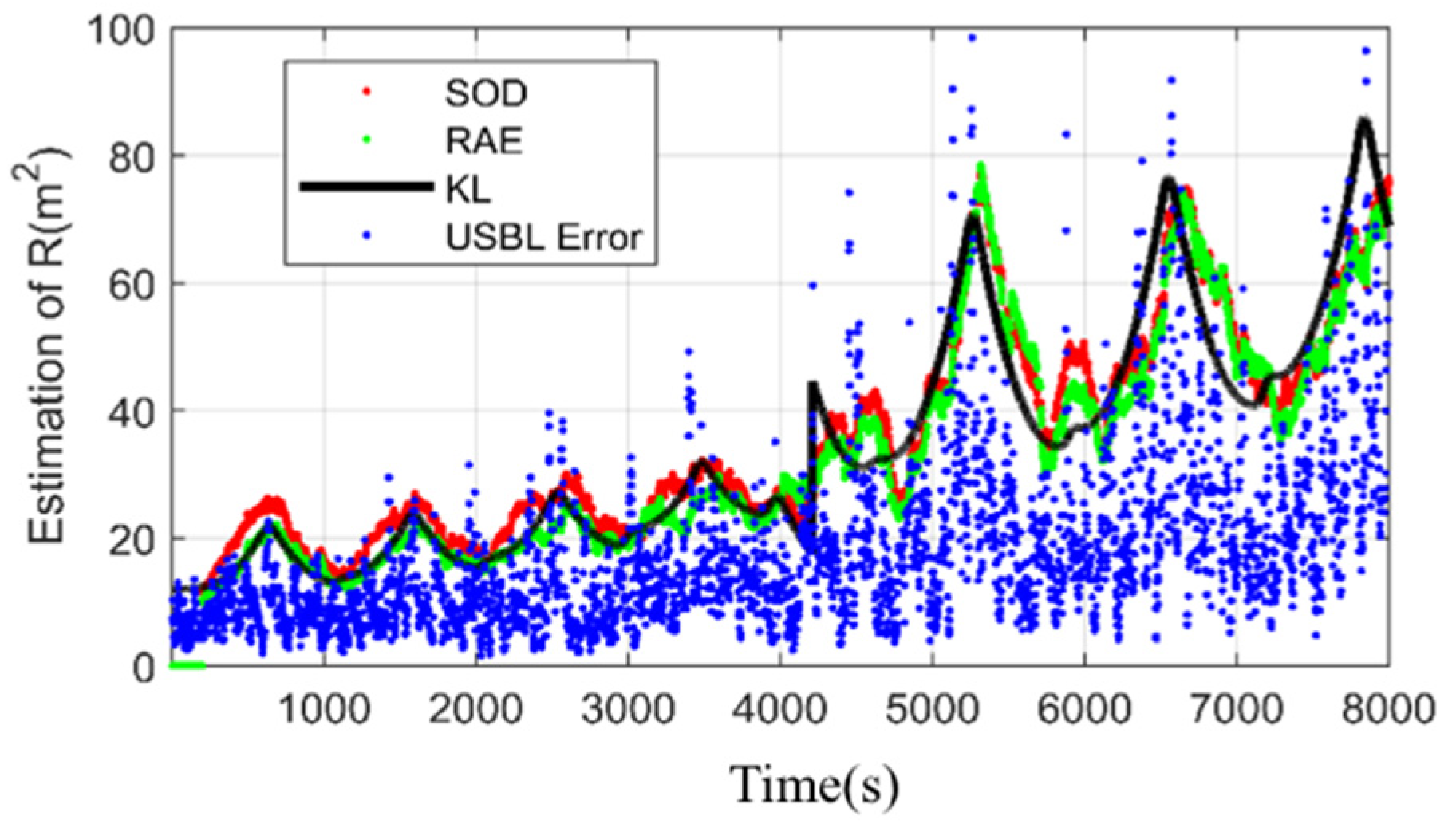
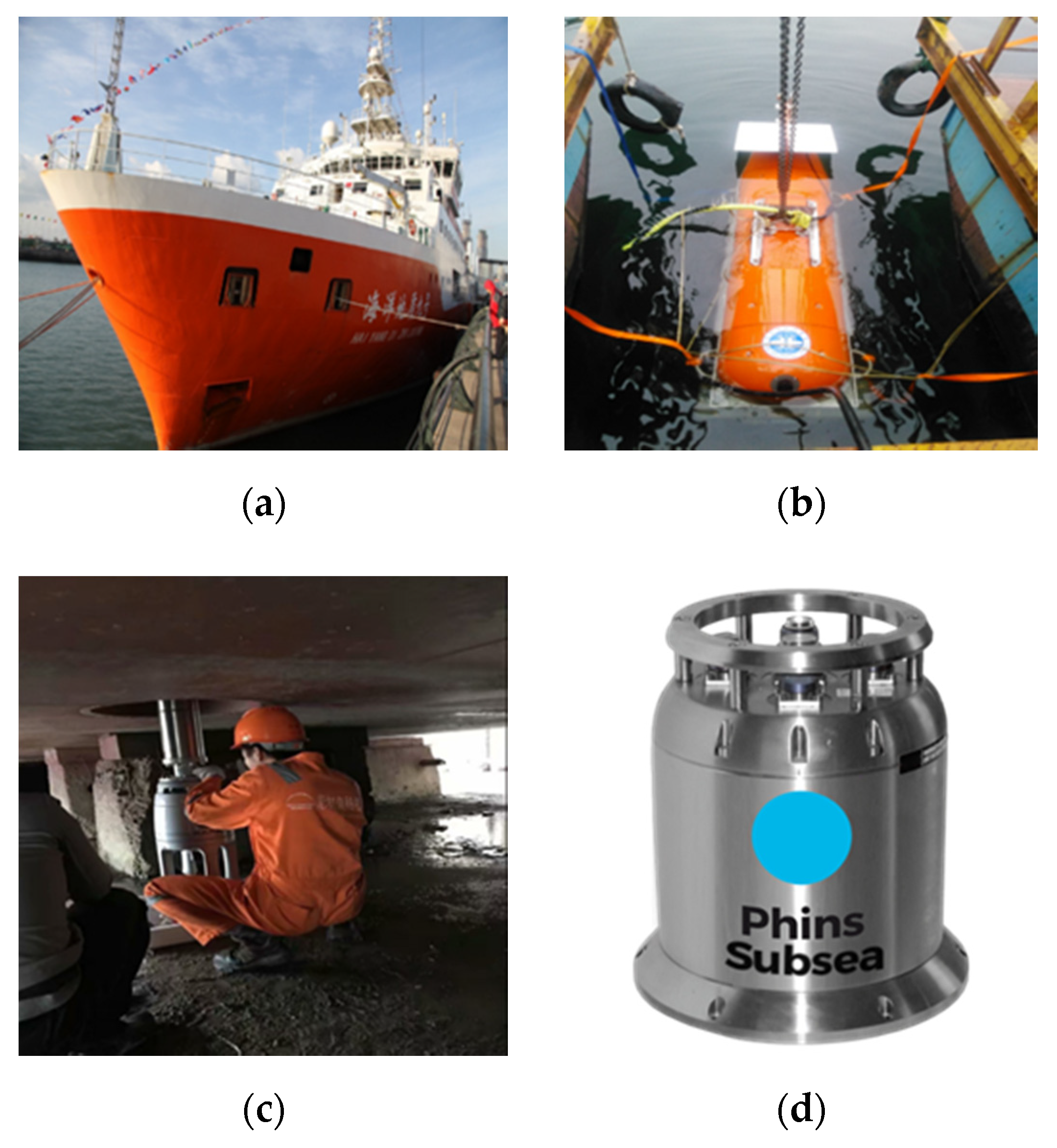

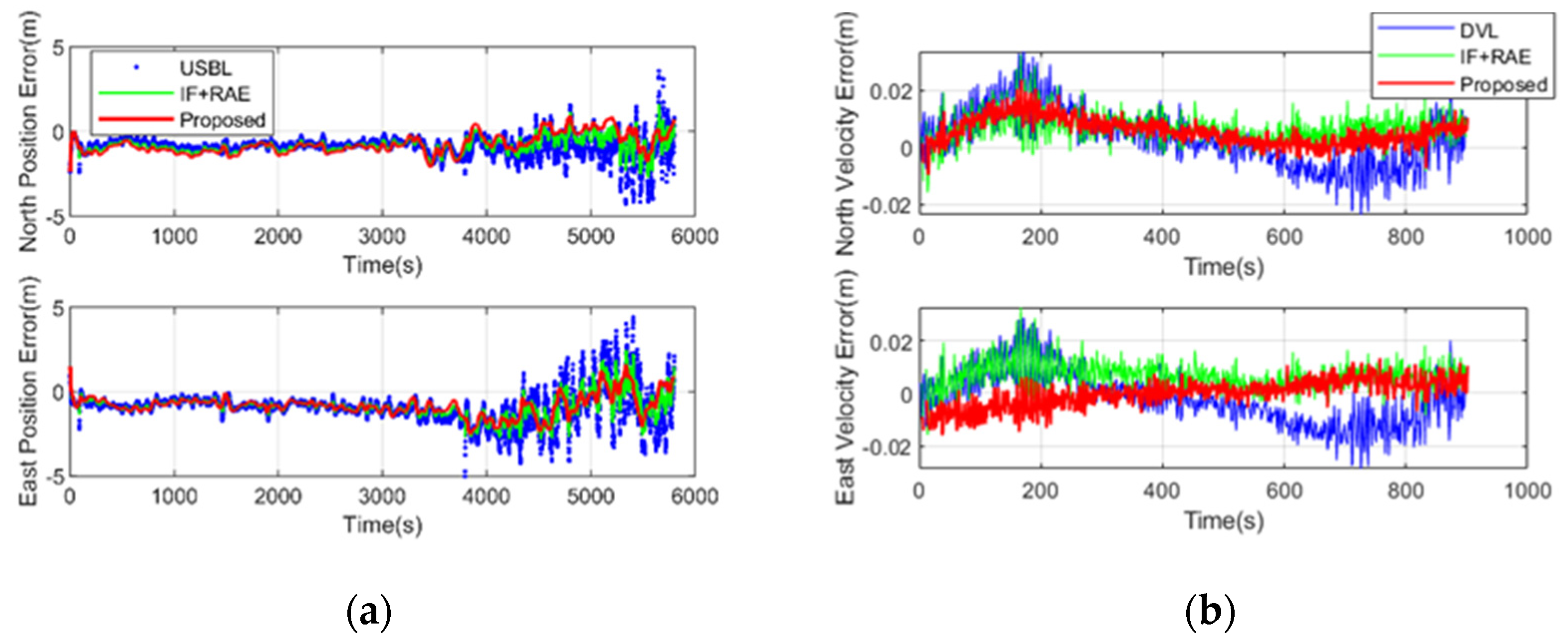
| Estimate | Measurement |
|---|---|
| AHRS pos. | USBL Ranges |
| AHRS vel. | Relative vel. to fluid |
| Currents vel. | Angular vel. |
| Depth |
| USBL (m) | DVL (m/s) | Depth (m) | Heading (°) | Roll/Pitch (°) | |
|---|---|---|---|---|---|
| Gaussian Error | L × 0.1% × K | 0.03 | 0.5 | 0.3 | 0.1 |
| System Error | 0.5 × cos (t/3600) | V × (1 + 0.05) | 0.3 | 0.03 | 0.01 |
| Method | Proposed | ARAE | IF | AIF |
|---|---|---|---|---|
| K = 2 | 1.06 | 1.08 | 1.43 | 1.16 |
| K = 4 | 1.90 | 2.13 | 2.51 | 2.42 |
| K = 8 | 2.47 | 2.79 | 3.20 | 3.17 |
Publisher’s Note: MDPI stays neutral with regard to jurisdictional claims in published maps and institutional affiliations. |
© 2020 by the authors. Licensee MDPI, Basel, Switzerland. This article is an open access article distributed under the terms and conditions of the Creative Commons Attribution (CC BY) license (http://creativecommons.org/licenses/by/4.0/).
Share and Cite
He, K.; Liu, H.; Wang, Z. A Novel Adaptive Two-Stage Information Filter Approach for Deep-Sea USBL/DVL Integrated Navigation. Sensors 2020, 20, 6029. https://doi.org/10.3390/s20216029
He K, Liu H, Wang Z. A Novel Adaptive Two-Stage Information Filter Approach for Deep-Sea USBL/DVL Integrated Navigation. Sensors. 2020; 20(21):6029. https://doi.org/10.3390/s20216029
Chicago/Turabian StyleHe, Kaifei, Huimin Liu, and Zhenjie Wang. 2020. "A Novel Adaptive Two-Stage Information Filter Approach for Deep-Sea USBL/DVL Integrated Navigation" Sensors 20, no. 21: 6029. https://doi.org/10.3390/s20216029
APA StyleHe, K., Liu, H., & Wang, Z. (2020). A Novel Adaptive Two-Stage Information Filter Approach for Deep-Sea USBL/DVL Integrated Navigation. Sensors, 20(21), 6029. https://doi.org/10.3390/s20216029






